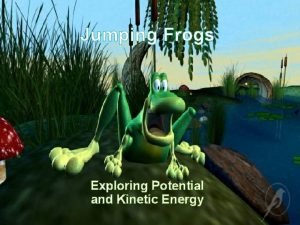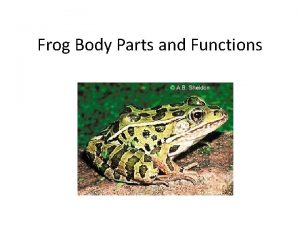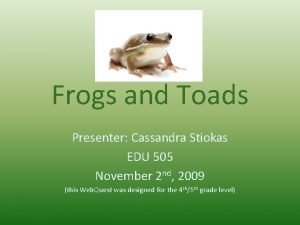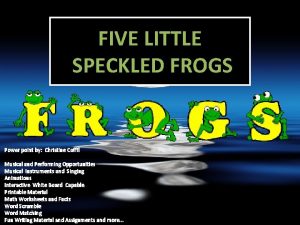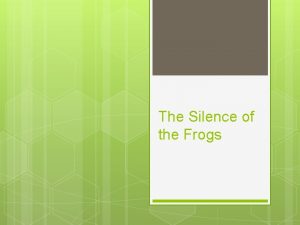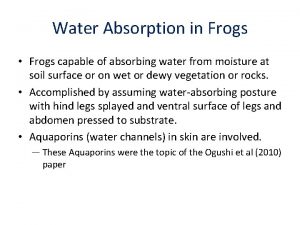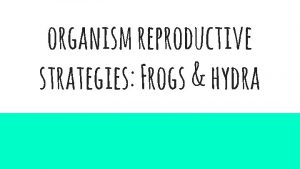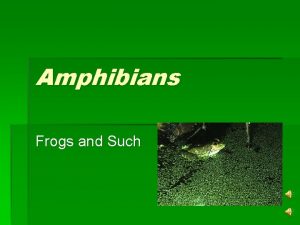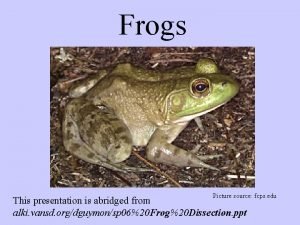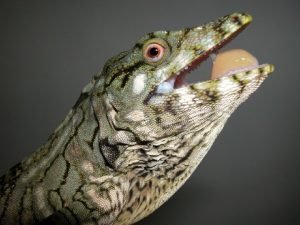What are Frogs What are Frogs Frogs are











- Slides: 11

What are Frogs?

What are Frogs? • Frogs are amphibians. They evolved ~280 million years ago. • Amphibian means ‘two lives’. • Amphibians include frogs, toads, salamanders and caecilians (snake-like animals). • Australia has ~200 species of native amphibians (all frogs!). • Frogs are cold-blooded, vertebrate animals.

Features of a Frog Protruding eyes Tympanum (ear drum) Backbone and internal skeleton External nare (nostril) Soft, moist skin Simple sac-like lungs Fore limb Adults have no tail Hind limb (for jumping) Digits (4 fingers, 5 toes) TITLE OF PRESENTATION

Frog Skin • Frogs live on land in water. • Their specialised skin allows them to live on land. • Their moist skin has important biological functions including: – absorbing oxygen and releasing carbon dioxide – regulating their salt content and absorbing water – changing colour to camouflage themselves – secreting mucous to avoid drying out. TITLE OF PRESENTATION

Frog Life Cycle • Frogs have slightly different life cycles depending on their habitat. • Frogs have the following 4 basic stages in their life cycle: • • • Tadpole Breathe with external gills Hind limbs develop first • • Eggs Laid in or near water Eggs have no shell Need water so they don’t dry out • • • © Australian Museum TITLE OF PRESENTATION Metamorph Tail still present Fore limbs developed Adult Frog Tail absorbed Air-breathing Moist skin can dry out without water

Threats to Frogs? Frogs are susceptible to many changes in their environment: – Salinity can impact on a frog’s ability to regulate its salt/water balance. – Temperature change can affect the ecology of frogs by forcing populations to alter habitat use and spawning times. – Large changes in p. H can also impact the distribution of local species and, in some cases, they will move out of an area altogether. At present, frog populations are declining all around the world. – Using frogs as bio-indicators can be as simple as noticing that a formerly noisy frog habitat has become silent

Frogs in Australia • Australia is home to about 240 native frog species. • Frogs have adapted to many different habitats • Some frog can burrow • Some can clime trees • Some will live in your backyard The following slides show three frog species found in Australia.

Ornate Burrowing frog Limnodynastes ornatus • This frog is well adapted to burrowing when there is little water, and is often found far from the coast and in arid environments. • This burrowing species is usually active after rain.

Corroboree Frog Pseudophryne corroboree • This frog lives in the Australian Alps. • It is found in marshlands and forests under logs and vegetation. • It likes to breed in the sphagnum bogs. This is the most endangered Australian frog and their numbers are decreasing

Perons Tree Frog Litoria peronii • Common suburban frog • Has black and yellow marbling on its thighs and armpits • Eggs are laid in a floating raft which sinks a few hours later • Found hiding by day in plant pots, drainpipes • By night are sometimes seen on windowsills catching incoming insects

Image variable

